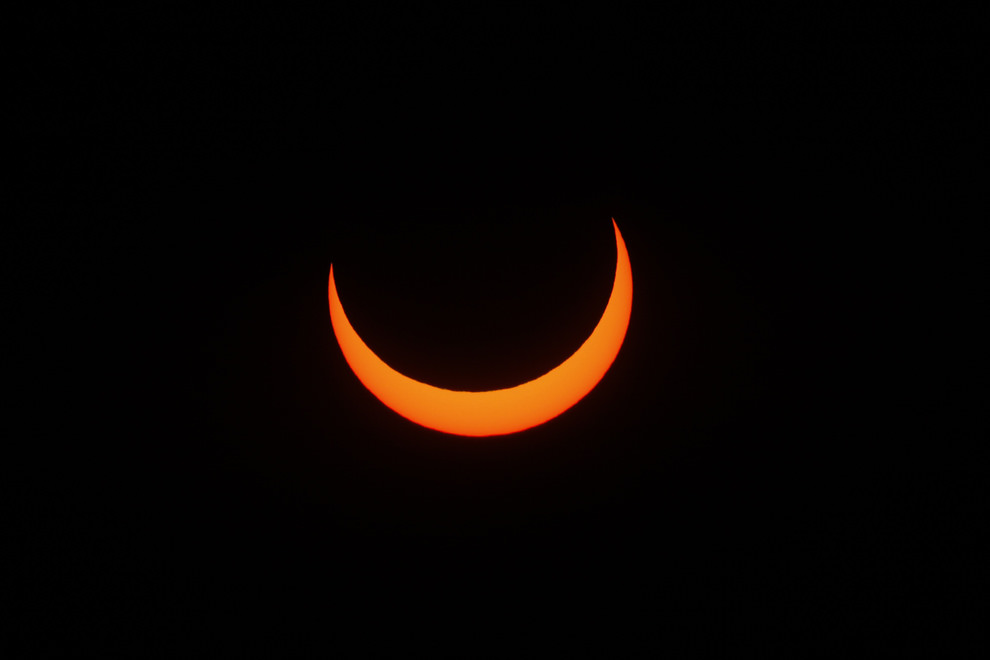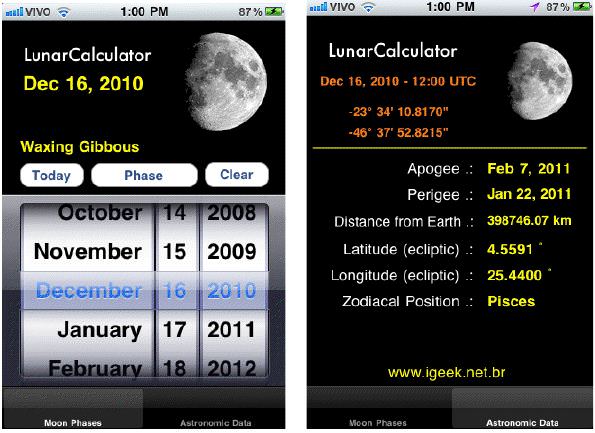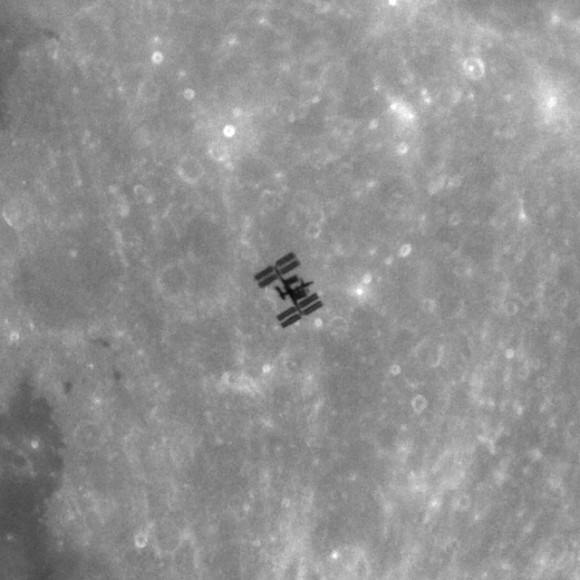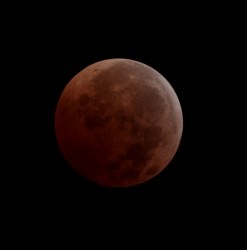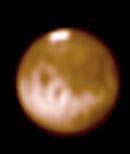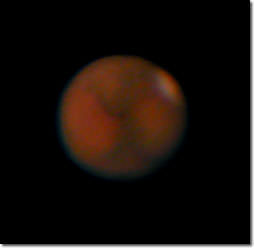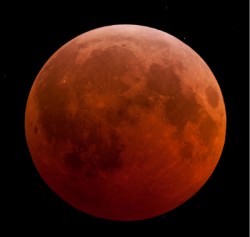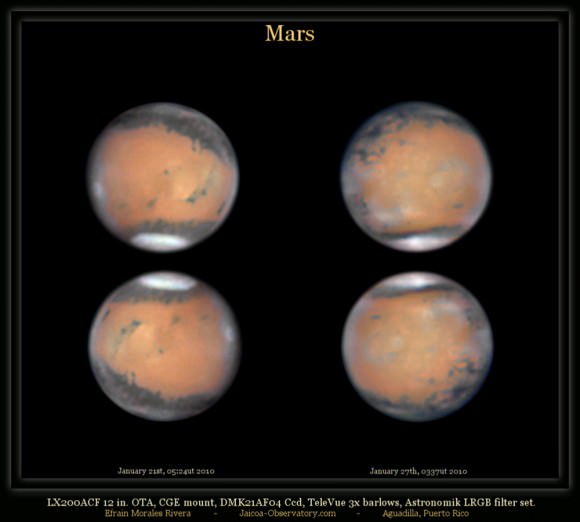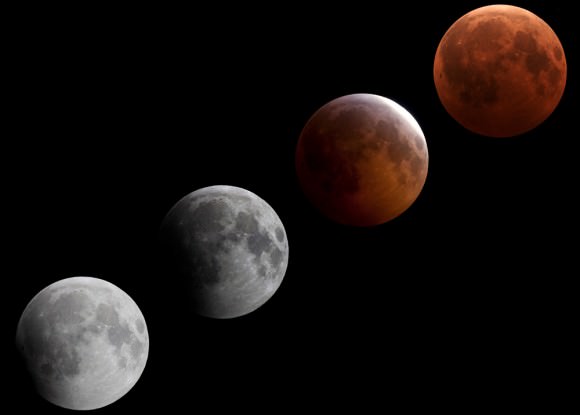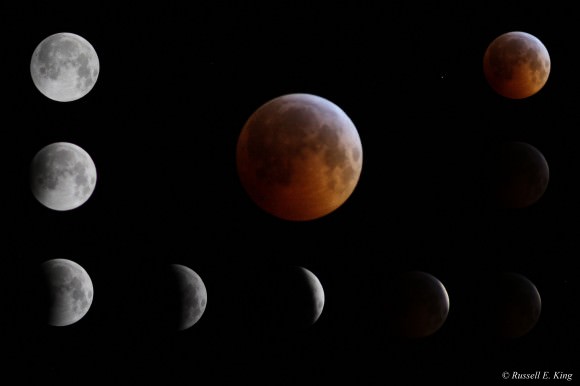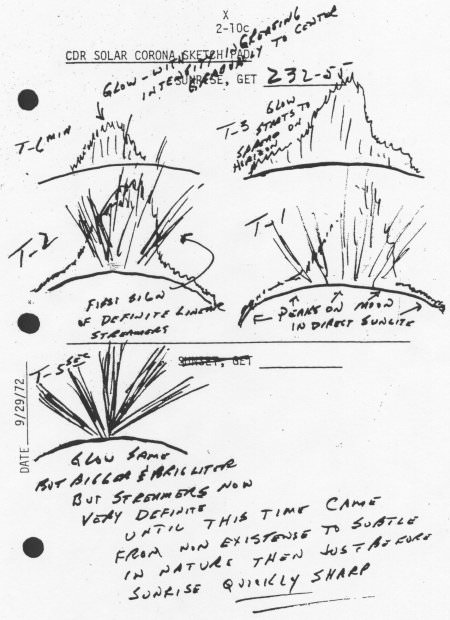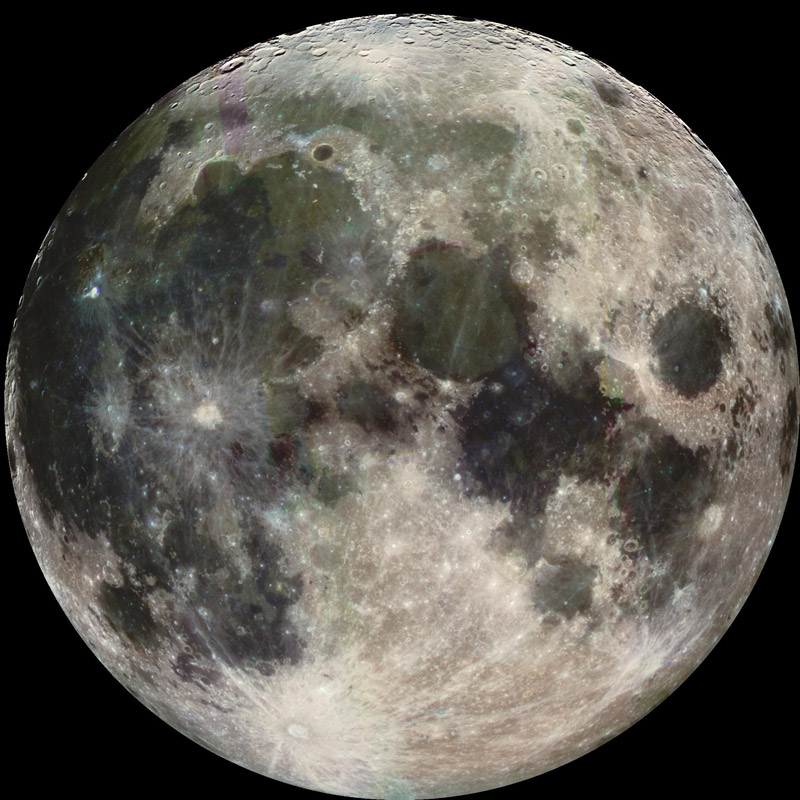[/caption]
Millions across Earth enjoyed one of nature’s most awesomely spectacular events during today’s (Jan. 4) partial solar eclipse – the first of four set to occur in 2011. And there was nothing partial about it, for those lucky eyewitnesses where it was visible in parts of Europe, Africa and Central Asia. The eclipse reached its maximum, about 85%, in Sweden. See the maximum stunner above – taken despite pessimistic weather forecasts -by Peter Rosen in Stockholm, Sweden, with more photos from the sequence here at spaceweather.com
Probably the most technically amazing feat is the double solar eclipse captured in one image by renowned astrophotographer Theirry Legault – see below – boasting both the ISS and the Moon on the eclipsed sun’s face. Legault had traveled to the deserts of the Sultanate of Oman, near to the capital of Muscat, for this rare spectacle of nature. The ISS was calculated to be visible in a thin strip barely 11 kilometers wide, according to Astronomie Info news. The ISS transit lasted just about 1 second, speeding by at 28,000 km/sec.
See a global compilation of gorgeous eclipse photos here and comment or send us more.
Update 1/6/11: this is a work in progress so please check back again.
New readers photos and eyewitness accounts added below today; as received
Click to enlarge all photos
First up: Double Solar Eclipse by renowned astrophotographer Theirry Legault in Oman
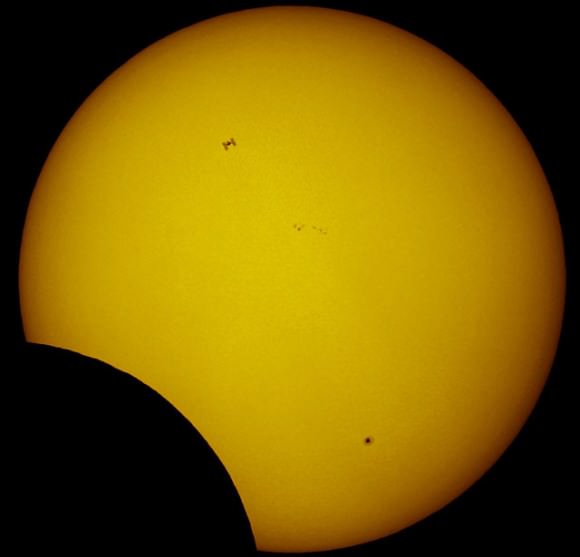
Check out this exciting gallery of images contributed by eclipse watchers from multiple locations around the world, on Flickr
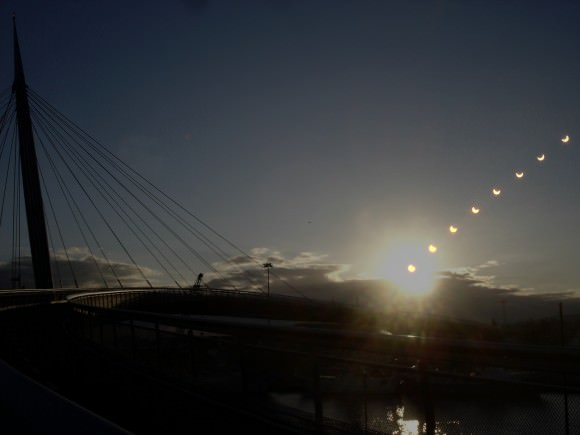
Here is a collection of images and an eyewitness report sent to me by Marco Di Lorenzo, in Pescara, Italy
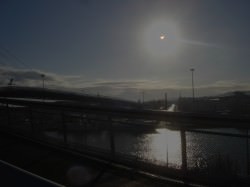
Marco writes; Pescara is located at 42.467°N and 14.225°E, about in the center of Italy on the Adriatic sea. I chose my location at the new pedestrian bridge because it is a modern structure which offers a nice foreground and also an open, elevated viewpoint. I used a couple of cameras plus a digital video camera. All the cameras were mounted on a tripod.
The weather was cold and the situation didn’t improve in the mid morning. Illumination was comparable to a slightly foggy day. The frigid temperature didn’t encourage people to go out and check. However some people did venture out. Someone asked me some info on eclipses and how to take pictures of it – very hard indeed, especially if you use a cellular phone !
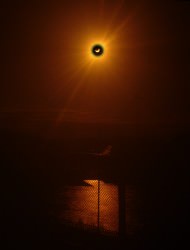
Urijian Poernick sent these photos and description:
“Colorful Solar Eclipse” at Halley Astronomical Observatory, Heesch, The Netherlands
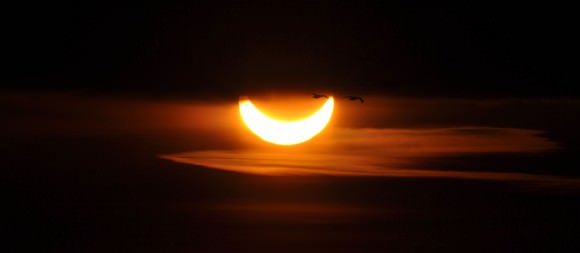
The weather forecast predicted overcast skies with only a few small bright intervals in all parts of The Netherlands. Nevertheless, dozens of members of Halley Astronomical Society and visitors, including many children, challenged the cold winter weather and came together on the flat roof of Halley Astronomical Observatory in The Netherlands.
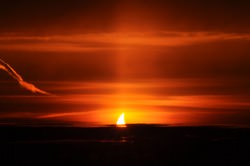
Due to the clouds and veils it was a very colorful eclipse, with all tints of red and yellow. After twenty minutes the sun and the moon disappeared behind the overcast skies again and they didn’t come back before the end of the eclipse (9:39 UT).
During this short period everyone could watch the eclipse through the telescope and we were all enthusiastic. It was a beautiful spectacle! www.sterrenwachthalley.nl
Gianluca Masi is the National Coordinator of Astronomers Without Borders in Italy and captured this pair of photos from partially overcast Rome, Italy. The clouds contributed to make for a delightfully smoky eclipsed sun
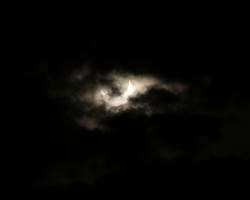
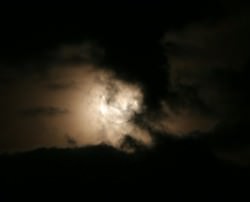
Edwin van Schijndel sent me this report from the Netherlands:
I made some pictures in the southwest of the Netherlands. The weather conditions were not so good in the early morning, most places were covered by clouds so we decided to move about 70 miles to the southwest from our hometown. Finally we stopped not far from the city of Bergen op Zoom and were able to see sunrise while most of the sun was covered. It was splendid!
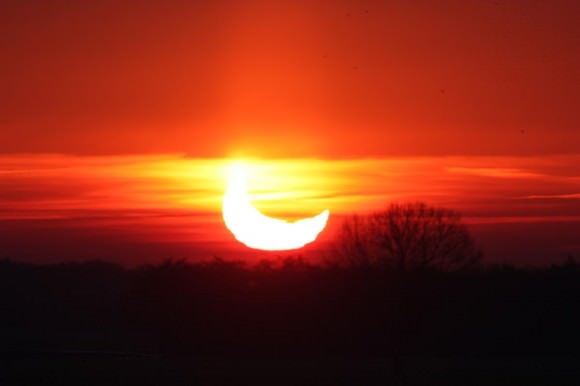
Unfortunately there came more clouds so the rising sun disappeared and we drove 20 miles to the north just before Rotterdam and the sky was more clear at this place. Again we took some pictures but the maximum covering of the sun had been a few minutes before. After all this wasn’t really a pity, we were very lucky to have seen the rising of the sun and be able to make some nice pictures of the partial eclipse. Many people in the Netherlands saw less or even nothing.
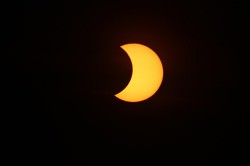
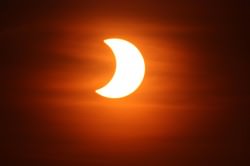
Send us or comment more solar eclipse photos to post here. ken : [kremerken at yahoo.com]
Look here for some photos from the recent total lunar eclipse on Dec. 21, 2010
Read a great preview about the eclipse by Tammy Plotner
…………………..
More Readers Photos and Eyewitness Accounts. Beautiful, Thanks ! ken
Story and Photos sent me by Stefano De Rosa. Turin, Italy
Early in the morning, I moved to a site close to Turin (Italy) where the forecast was not so bad as in my city to try to observe and photograph the partial solar eclipse. Unfortunately, when I arrived it was cloudy and foggy and so decided to go back home. Technical details: Canon Eos 1000d, F/22; 150-500mm lens @ 500mm; ISO. 1/1600 sec
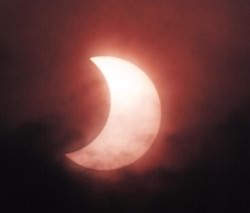
Suddenly, as I was sadly driving on the motorway, close to the city of Alessandria, noticed a little break on the clouds from my rearview mirror: I stopped the car and, after a quick set up, managed to capture the crescent Sun!
http://ofpink.wordpress.com
Well, I hope you carefully looked back before hitting the brakes ! – ken
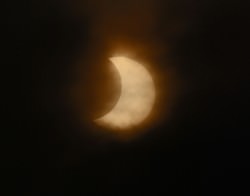
……..
Story and Photos sent me by Roy Keeris, Zeist, The Netherlands
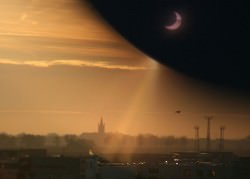
Me and a friend (Casper ter Kuile) wanted to see the eclipse from The Netherlands. If clouds should intervene, we planned to drive a little (max. a couple of hours) to a place with a better chance for a clear sky. During the night we checked weather forecasts and satellite images. We were pretty unsure if we would succeed in seeing the eclipse, because it was pretty cloudy, and especially the low clouds tend to be quite unpredictable. In the end we chose to drive to Middelkerke (near Oostende) in Belgium because of a clear spot approaching from the North Sea.
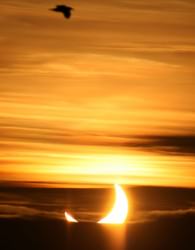
We arrived at the Belgian coast just in time before sunrise. There we witnessed the eclipse from the top of a dune. About 25 minutes after sunrise the sun appeared from behind the lower clouds, just when the eclipse was at its maximum. It was magical!
First we saw the right ‘horn’ and then the left one appeared. From then on we watched the rest of the eclipse and took many pictures. [no pics from Casper ??]
Later we heard that despite the clouds, many people in The Netherlands were able to see the eclipse. There was a long stretch with a clear zone in the clouds- near the border of Germany.

If they had a clear horizon, people could look underneath the clouds and were just able to see the sunrise. I could even have seen it at home from my apartment on the 13th floor! But the trip was fun. It’s always nice to hunt for the right place to be at these events.
Here are some pictures I took from Middelkerke. They were shot with a Canon 400D in combination with a Meade ETS-70 telescope and a Tamron 20-200mm lens.
Thanks – Yes the hunt is half the fun. ken
………………
Story and Photos sent me by Igal Pat-El, Director, Givatayim Observatory, Tel Aviv, Israel
We took some images of the Jan. 4 Solar Eclipse from the Givatayim Observatory, just near Tel-Aviv, Israel. We were pleased to have Prof. Jay Passachoff as a guest during the eclipse. We had a live broadcast in plan but we had to cancel it due to heavy rain from the first contact, therefore we closed the dome’s shutter and went to the balcony trying to take some quick photos of the eclipse.

Collage assembled by Ken Kremer
We had the portable PST Coronado CaK telescope with a Ca filter On a Alt-Az mount (we could not do any alignment due to the rain). We took about 5 images against all odds in this very dim filter, using the Orion SS II Planetary imager, all of them through the haze and clouds.
Thanks, Igal. Another good lesson learned. Take a chance. You never know what you’ll get till you try !
I’ve combined Igal’s photos into a collage for an enhanced view. ken
See more photos and a video in comments section below

